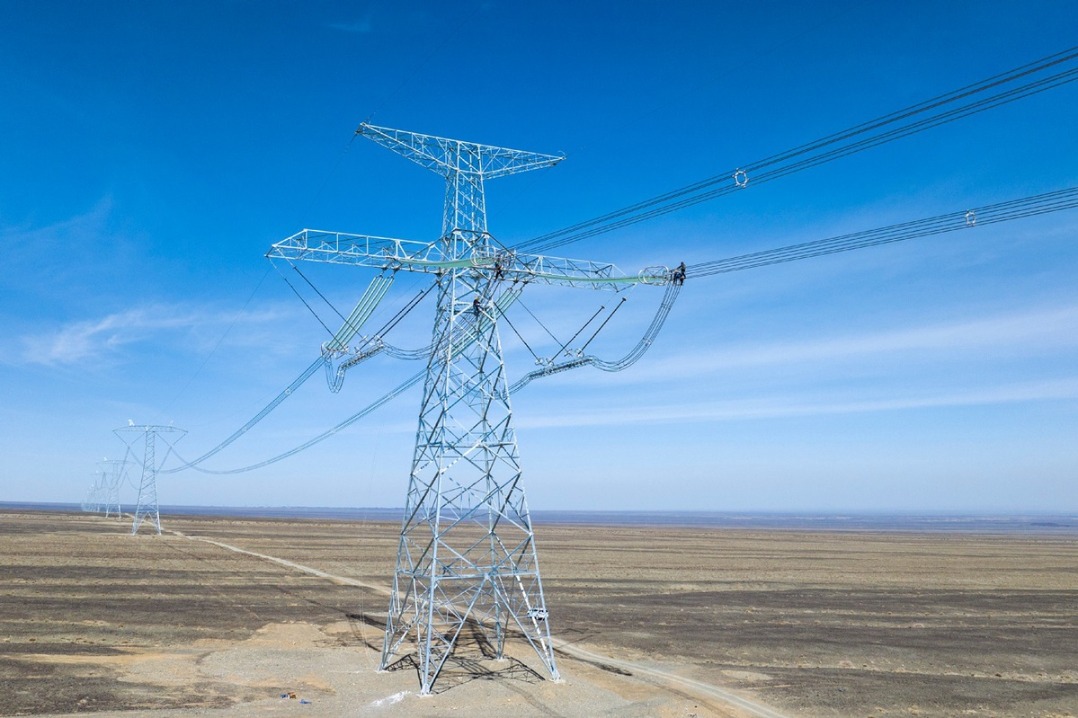Solar needs 'visible', 'invisible' guiding hand
Experts call for joint efforts from government and industry players to improve market conditions


China will step up efforts to guide the construction and release of upstream solar production capacity to avoid repetitive building of low-end capacities, after major solar manufacturers urged increased government intervention to create a favorable market environment for the industry.
The National Energy Administration has vowed to guide capacity expansion and avoid redundant investments, monitoring solar factory utilization and expansion plans to help improve market conditions.
This comes in response to solar companies' call asking Beijing to step in after a surge in capacity caused equipment prices and profits to shrink.
Solar panel makers, including Trina Solar Co and GCL Technology Holdings Ltd, converged at the International Solar Photovoltaic and Smart Energy conference in June and called for industry collaboration, as a jump in capacity has led to a steep plunge in prices of solar cells and modules, slashing the industry's profits.
The growth of solar power over the past two decades has been phenomenal, from a niche sector to the world's dominant source of new energy. The world added 445 gigawatts of solar panels last year, mostly from China, propelling the growth of multibillion-dollar companies, which are now comparable to the giants of oil and gas.
On the other hand, solar prices have been dropping in China after a breakneck expansion created much capacity, forcing many firms to sell at lower prices. The country's dominance of the world's solar supply chains, which is being challenged by protectionism overseas, has made solar companies fret even more.
Still, low prices are helping speed up clean energy adoption. Industry insiders believe China and the global market are showing strong demand prospects for clean energy, prompting solar industry players to further expand capacity over the long term.
China's strong production ability makes what should be expensive products affordable to consumers. There are more people willing to use solar products, because it is not only cheap, but also environmentally friendly, said Ma Yinqiong, a senior analyst covering metals and supply chain materials at Rystad Energy.
China's solar industry is going through a period of technological upgrade. Government guidance and intervention that mainly focus on expanding domestic demand, optimizing capacity construction and strengthening innovation capacity, are expected to help the solar industry transition through this period, she said.
The government has vowed to further consolidate the market for new PV power installations domestically while accelerating the construction of a new energy infrastructure network to improve the grid's ability to accept, allocate and regulate new energy generation, including PV.
It will also strengthen multi-departmental coordination, while continuously enhancing PV technology innovation capabilities to reinforce standard innovation leadership, said Li Chuangjun, director-general of the administration's renewable energy department.
Zhu Gongshan, chairman of GCL Technology Holdings Ltd, said he believes breakthroughs in core technology can help avoid over-competition in China's solar sector and lead to the expansion of industry limits.
Taking perovskites as an example, which have achieved in over 10 years what crystalline silicon solar cells took 50 years to accomplish in terms of technological evolution, Zhu said the depth and breadth of its technology far surpass traditional technologies, requiring complex model architectures, extensive empirical research and full-element technical matching.
"Only those focusing on cutting-edge innovations, from advanced photovoltaic materials to AI-driven energy management systems, can stand out from the white-hot competition," he said.
Zhu called for more efforts to support the construction of perovskite demonstration power plants, accelerate the market validation of perovskite technology, and promote the rapid industrialization of new photovoltaic technologies to create a new ecological landscape.
"This is especially necessary as the solar sector's overall capacity has nearly tripled, while profit margins have declined by around 70 percent, and the entire industry chain is under pressure. Trade barriers from Europe and the United States are leading to shrinking overseas demand and declining exports," he said.
"The government should also take actions to stop 'over-investment' in the industry as the plunging prices of solar cells and modules are eroding profits, help coordinate the industry's development to avoid over-competition, and come up with guided actions to protect manufacturers from low bids.
"China's photovoltaic industry urgently needs the government's 'visible hand' and the market's 'invisible hand' to work together and make structural adjustments by improving technical standards and market access thresholds," he added.

Longi Green Energy Technology Co, one of the world's largest solar panel manufacturers, announced in June a new world record efficiency of 30.1 percent for commercial M6 size wafer-level silicon-perovskite tandem solar cells, an emerging photovoltaic technology that is being actively researched by the global photovoltaic industry.
The company's research into mass production technology for tandem solar cells in recent years has boosted the global photovoltaic industry's confidence and expectations for silicon-perovskite tandem solar cell technology, it said.
The company has attached great importance to research and innovation in technology since its establishment, as "technological innovation and intelligent manufacturing help the photovoltaic industry move toward new prosperity", said Dennis She, vice-president of Longi.
The clean energy sector accounted for around a fifth of China's 5.2 percent gross domestic product growth in 2023. Beijing has identified solar panels, electric vehicles and lithium batteries as the three new pillars of the country's economic growth.
Figures released by Citibank show that more clean energy capacity addition is expected from large-scale wind power and photovoltaic plants in China this year, with a focus on deserts in the country and from offshore wind power, as well as from large-scale hydropower plants, biomass energy and hydrogen energy.
Rystad Energy said renewable capacity installations in China have maintained a high pace since last year, with the trend continuing, supported by a number of under-construction or planned large-scale renewable base projects.
Industry executives speaking at a conference recently also called for an end to race-to-the-bottom price competition. They suggested bidding processes take into account levels of R&D, instead of just pricing.
Zhong Baoshen, chairman of Longi, believes technological innovation will be the core driving force with the scale of the PV industry continuously expanding and costs decreasing.
After more than 20 years of ups and downs, solar power has become the cheapest source of electricity in the vast majority of countries worldwide, playing a significant role in global energy transition and sustainable development. China, meanwhile, has made significant contribution to global low-carbon energy transformation, he said.
In response to the protectionism being applied in some countries, Zhong called for more cooperation to address challenges facing global energy transition and the impact of climate change.
"Only through global cooperation and the optimization of the allocation of resources through free trade can we accelerate this transformation and make it cheaper," Zhong said.
Despite its rapid expansion, the sector is marred by various irregularities, as well as a lack of proper infrastructure such as grid connectivity and transmission lines to distribute solar energy effectively. In this context, government support and industry collaboration can further facilitate the sector's long-term development, he said.
Longi believes consolidation will be "good for the leading players" in the country.
Due to restrictions imposed by the US and the EU, as well as intense competition at home, the oversupply issue in China's solar industry is likely to persist until late into this decade, even without new capital expenditure, according to a report from Daiwa.
A joint effort by the industry is required to avoid overinvestment, said Gao Jifan, chairman and CEO of Trina Solar and honorary president of the China Photovoltaic Industry Association.
Government regulation of new investment in the sector is needed to plug further losses, Gao said.
Believing that the development of energy storage would ease the current capacity issue, GCL Group has continuously invested in energy storage as well as smart grid networks to further enhance the competitiveness of new energy solutions.
Energy storage systems are crucial for integrating renewable energy sources like solar and wind into the grid, as they can store excess energy generated during peak production time and release it during periods of high demand.
It has come up with a large number of high-quality user-side energy storage projects in the country's more developed regions such as the Yangtze River Delta and the Pearl River Delta, based on the company's photovoltaic industry chain resource advantages and multiple types of energy supply services.
The company will continue to expand various business models such as demand management, demand-side response, light storage integration and virtual power plants, and increase the development of industrial and commercial energy storage, it said.
By the end of the first quarter, China had 52.5 GW of pumped storage capacity and 35.3 GW of new energy storage capacity, with a strong under-construction or planned project pipeline to support near-term capacity growth, according to Rystad Energy.
























